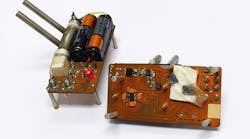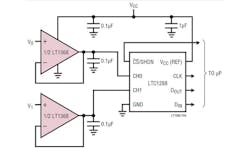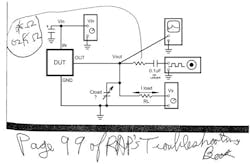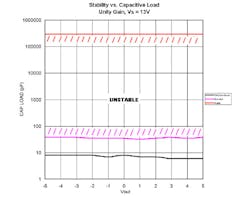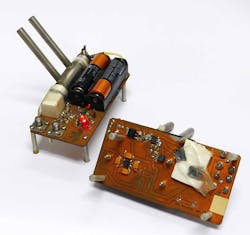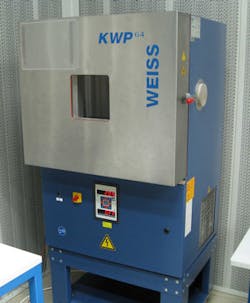In 2008, Bob Pease exchanged e-mails with Linear Technology’s Mark Thoren, me, and a few other friends. The subject was how an amplifier will oscillate if you put a capacitive load on it. Bob knew this was a tough subject. “So any fast, nimble, low-noise amplifier may get grouchy about capacitive loads. In some cases, a series R-C damper can help. There are no easy answers,” he wrote in “What’s All This Ripple Rejection Stuff, Anyhow? (Part 3).”
This file type includes high resolution graphics and schematics when applicable.
Ever the instigator, I started the conversation when I wrote Pease and Thoren, commenting about op amps designed to handle capacitive loads.
“I have many instances of customers complaining that our DACs oscillate, only to find out that they C-loaded them. How many customers do you suppose just got lucky in that the amplifier they chose happened to be stable with 0.1 µF on the output?” Thoren responded first.
Related Articles
- What's All This Meter Accuracy Stuff, Anyhow?
- What's All This Solenoid Driver Stuff, Anyhow?
- What's All This RIP (Rest In Pease) Stuff, Anyhow?
“The LT1368 is a load-compensated op amp that requires a capacitive load for stability. Of course it’s not very fast, but it makes a great ADC driver because the CLOAD provides the sampling circuit’s transient current, and the op amp provides the microamp or two of average sampling current,” he continued (Fig. 1).
“And on that note, if you just need a buffer and it only needs to source current and you can tolerate a couple of millivolts of offset, you can use an LT3080 regulator, once again, requiring a CLOAD. I just thought I’d throw out a couple of interesting circuits, hopefully not too off-topic or blatantly advertising,” he said.
When I recently reminded Thoren about his comments, he had more to say.
“The LT1368 is fresh on my mind because we use it in the LTC2449 demo board, as an ADC driver. Unfortunately its fairly slow settling time translates to a gain error in the high-speed modes, as the amplifier slews mid-conversion,” he said.
“The solution is shown in Design Note 400, and I just added this circuit to the demo board as a ‘stuff’ option because I take so many calls on it. The design process for that circuit is another long discussion, involving finding the CLOAD value that is large enough to attenuate ADC sampling disturbance enough to not upset the amplifier, but small enough to allow decent settling. And a bunch of other stuff. And a lot of experimentation.”
Note how empirical all this stability research is. To Thoren’s original comment seven years ago, Bob Pease responded:
“Brief comments to all you guys, on op-amps that are supposed to be decent at driving CLOAD, notes from RAP,” he began.
“I have found that LOTS OF op-amps are decent for driving CL, BUT not for all loads. Even a crappy old uA741 can do a lot of things right, in some cases, some applications. I’ve seen datasheets that recommend an op-amp for almost any cap load. But when you look at the ‘Phase Margin,’ they ain’t got very much. They may not oscillate, but they could ring like a bell.
“(A) There is no substitute for setting up your amplifier and adding the actual kind of cap load. Set it up with the right noise gain and everything else the same as you will use. If you are going to use it with electrolytic 1 μF, don’t waste your time with 1 μF of Mylar or ceramic — nor vice versa. (A’) Needless to say, SPICE is worse than useless for this. It lies. Badly.
“(B) Exercise the amplifier over its working range of IOUT (dc) and VOUT and CL. And, to do it right, OVER TEMPERATURE... And if you are going to try to use more than one amplifier manufacturer, make sure you check them carefully, and then lock out all other makers. A third source can easily be JUNK.
“(C) Don’t just see if it oscillates — see how it RINGS when you tickle it with a pulse of current. In other words, BANG ON IT.
“(D) As recommended in the Page Attached,1 a series R-C damper may help. Etc., etc.....(Fig. 2).
“(E) [Former National Semiconductor application engineer] Walt Bacharowski says that the LM8261 is really pretty decent. I’ll take his word on that.
“(F) I wish I could recommend some of our CMOS rail-to-rail amplifiers, that could drive a big CL, but most of them are rated up to 120 to 240 pF. Refer to the datasheets. I wish I could name a good one; but most of ours have a Miller loop around the output stages. For small CL, this is excellent; but for large CLs, that loop doesn’t like the CL. Even the normal de-coupling schemes don’t work well.
“I wish I could tell all you guys, ‘Shout it from the Hilltops,’ but technically this page, as attached, is copyrighted by EDN and Cahners and Elsevier and Butterworth-Heinemann, and Jesus knows who all else [Note, Fig. 2 has been redrawn]. But you can pass it around, what the hell. I don’t need ANY ‘Friends of Analog’ to get screwed by lack of this information.
“Best wishes. / rap / Robert A. Pease, Apps guy.....”
As always, Bob was passing on some good advice, learned over decades of getting real circuits running. I will reiterate his caution to test your circuit’s stability over temperature, and especially cold.
As a system engineer, I used to think that I only had to test at hot, since that is what burned up the chips and let out the Magic Smoke.2 After working as an apps engineer alongside amplifier IC designers, I learned that the transconductance of the transistors in an amplifier gets higher at cold temperatures. Colder temperatures make for faster transistors. This will reduce your phase margin and can set up oscillations.
This is why many amp makers sell most of their parts at a –40°C rating. It is a real challenge getting that full military temperature rating down to –55°C. In addition to the higher transconductance of the transistors, the base-emitter voltage (VBE) of bipolar transistors gets higher at cold temperatures. This can also screw up the amplifier performance at cold extremes.
Now if you are new to electrical engineering or not an analog specialist, you still might wonder why hanging a capacitor on the output of an op amp will make it oscillate, but only sometimes. Once again, Bob Pease to the rescue. Where IC designers will describe the problem in the frequency domain, Pease preferred to think and explain in the time domain. He told me that “We all start out with an oscilloscope, and some of us will never use a network analyzer.”
So whereas an IC designer would say, “An output capacitor puts a pole in the ac response,” Pease would use the time-domain equivalent by saying, “An output capacitor puts a lag in the ac response.” So when you realize the capacitor is putting in a delay, you can start to see why the system will tend to oscillate.
Let’s say you are sitting in a racecar video game. You have a steering wheel and projected on the screen is a sinusoidal racetrack coming towards you. You are the op amp in this thought experiment. So the track is coming towards you and the steering is fast and tight and it’s pretty easy to follow the track as it swerves from left to right and back again.
Now put a delay in the steering response. You turn the wheel right and it takes, oh, a half-second for the “car” to go right. You can see that you would tend to steer way too far to the right, waiting for the car to go that way. Similarly the op amp is pumping current into the capacitor but the voltage is not rising right away. So then you turn further and further and pretty soon, the car does start moving but just when it gets really going to the right, the track has turned left and you run off the road.
That is analogous to the op-amp output pegging to the power supply rail. And just like a car run off the road, now your op amp has real problems. All its transistors are saturated, trying ever-so-hard to source current, so it may take milliseconds to sweep all the free carriers out of the base regions and get the op amp sinking current instead of sourcing it.
And just like a fast car will be harder to keep from oscillating, fast amplifiers are often hard to tame. Some of the fastest amplifiers can only take 10 or 20 pf of output capacitance. Bob Pease’s protégé, Paul Grohe over at Texas Instruments, notes that “A fast amplifier wants to look into a back-terminated resistor a few millimeters from the output pin.”
So now you can envisage why Pease’s technique of perturbing the output tells you so much. It’s conceivable your amplifier will not spontaneously break into oscillations, but will be so close that you dare not send it into production. “Banging on the output” is analogous to presenting your car video game with a hard corner followed by a reverse corner, like in the farm fields of Michigan where I have planted a real car in the cornfield (Fig. 3).
If the amplifier is over-damped, it won’t follow the road, but if it is under-damped, it will oscillate as you regain control. This is what the ringing on the oscilloscope trace shows you. A little ringing is okay, but a lot of ringing tells you to test at cold and put the highest cap load on the amp you think it will ever see.
Hanging around Pease and Grohe and Thoren has taught me some tricks to kill oscillations. When I was characterizing an amplifier I noted that it would get stable again as you increased the capacitive load (Fig. 4). I asked Paul Grohe what was going on.
“Well, with no capacitance everything is fine. A little capacitance and you are losing phase margin. Once you have gain at 180° phase, it will oscillate,” he explained. Grohe really helped me understand things when he said, “At 180° phase shift, that negative feedback pin you are hooked to is now a positive feedback pin.”
But he then noted, “When you hang a really immense capacitor on the output you are dragging down the gain even more than you are shifting the phase, so that you once again have phase margin, and the circuit is stable.”
Grohe went on to say, “As the C becomes even bigger (~0.1 µf), then the amp is loaded by the ESR of the cap, killing the ac gain even further. It is a big snubber. That is why folks use an op amp to drive a dc reference line, and hanging a big tantalum or ceramic cap on the output seems to work... but it will have poor load transient response.”
You can also do a lot of math to prove to yourself that a voltage follower is more subject to oscillation than a gained-up circuit or a simple inverting amplifier with a gain of –1.3 There are also noise gain tricks, where you can put a resistor between the two input pins and get some phase margin. The whole subject of noise gain is best left for another article.
When I asked Paul Grohe to look this article over, he had a few comments on the car analogy, only he used a bicycle:
“If you ‘dampen’ how fast you turn the handlebars to anticipate the lag in the wheel response, the end result is you cannot turn fast. So simple ‘damping’ will always slow down the loop response, your system’s bandwidth. If the end of the block is coming up, and you cannot turn fast enough... you plow through a few houses until you get to the next block. You would be in ‘integrating’ mode,” he said.
“If you make the handlebars wider like a Beach Cruzer, it is easier to control the steering, analogous to adding open-loop gain. If the handlebars are smaller, then it is more difficult to maintain control since you have low gain,” he added. “And you go into ‘phase reversal’ if you turn the handlebar more than 180°. I tried riding my bike with my hands crossed once... Once...”
You can see why the parts with unlimited cap load that Mark Thoren mentioned are such a lifesaver. If you are driving cables of indeterminate length, you should really think about using one of these parts. Linear Technology, Analog Devices, Texas Instruments, and all the big analog houses will have some amps that will drive unlimited capacitive loads. They can work like in my huge capacitor example. The external capacitive load just reduces the gain more than the phase. Your circuit might not operate as fast as you want, but it will not break into oscillations.
Barry Harvey, former IC designer at Elantec and Intersil, reminds us that “the output stage itself has a feedback loop that can go unstable no matter what you do.” He says some amps count on an external cap to create an output pole, but the IC designer has put a zero in the output stage to counteract the pole and ensure stability.
My college professors used to say that op amps all have a single dominant pole. But in reality, a modern op amp may have several poles and zeros, all trying to tailor the response as the gain crosses zero. It’s yet another reason to be wary of Spice, since the macromodels don’t always account for this sophisticated design.
So now you know to say, “Well, Joe, the cable is putting an output pole in the amp response that is causing the oscillations,” just as your boss is walking by. There is an analogous situation common when you have a capacitive input. This is common in photodiode amplifiers and other sensor interface circuits. Here the capacitance is on the input pin, not the output.
Go back to our video game car analogy. Instead of imagining a delay or output pole in the steering, think if there was a delay in what your eyes saw. Maybe a video delay or some magic glass slowed the image to your eyes by that same half second. You can see that this is just a different way to cause the same problem. Now the lag is on the input to you.
So for an op amp, the IC folks would say you have an input pole that is increasing noise gain until the rate of closure to the open-loop response is 40 dB/decade. But we know the problem is a simple input lag. You can fix that by adding some capacitance to the feedback to swamp out the effect of the input capacitance or reduce stray capacitance with better board layout and maybe a different amplifier.
I can’t encourage you enough to think long and hard about this phase thing.4 Grohe was dead-on when he said that if you have any gain at 180 phase shift, your minus pins magically turn into plus pins, and your circuit oscillates.
Here is an example where phase gave me some oscillation headaches. I was designing a CO2 sensor proposal for the Space Shuttle (Fig. 5).
The system would compare a reference voltage from a thermopile to the voltage from the same source that shined through a sapphire capsule with the astronaut’s breath. The CO2 would absorb the infrared radiation and put less output on the thermopile under the capsule.
I would servo the output to the heater filament to get the two thermopiles equal, and that drive voltage would represent how much CO2 was in the capsule. The filament didn’t even glow. The amplifier drove it to just get warm enough to emit long-IR (infrared). Sapphire does not absorb IR so it did not affect the measurement.
I used a chopper amplifier because the thermopile output was microvolts, and because this could be a slow reading, and because the source impedance was fairly low. I hooked everything up and my little servo system would oscillate at about 1 Hz. See, the microvolt signal off the thermopile was really noisy. The amplifier just added more noise.
I then put a big filter capacitor in the circuit, so the output to the filament was nice and smooth. But that filter capacitor also put in a phase shift that made the circuit oscillate. Being young and stupid, I put in a bigger filter capacitor. The circuit oscillated slower. I put in some huge filter capacitor. The output oscillated slower yet. I moved the filter from the feedback network to the output. Remember the subject of this article, CLOAD on an amplifier? Yup, the circuit still oscillated. Then all the college courses and theory hit me. I didn’t have a filtering problem. I had a phase-shift problem.
So I took all the capacitance out of the circuit. The CO2 sensor worked perfectly. It looked terrible on the oscilloscope. The output to the heater filament was so full of noise it looked like an earthquake graph. But what I realized is that the filament itself is a low-pass element. All the noise in the signal was smoothed out by the thermal time-constant of the filament. It was one of those circuits that looks bad, but works great.
So the point is to watch out for those capacitive loads, and capacitive inputs, and capacitive phase shifts. You can think of it as some high-falutin’ pole-zero jargon, or as a simple lag or delay. Be warned that Spice will show when something will oscillate, but you should never trust Spice to guarantee stability.5
The quality of amplifier models is quite diverse. Many will give you a stable output when the real-world part will break into oscillation. Or maybe your power rails have some impedance that causes the amplifier to oscillate. You need real parts and a temperature chamber to make sure (Fig. 6).
As Paul Grohe just wrote me:
“With a recent customer, there was a very slight production shift in phase margin and their borderline circuit started oscillating. They had hung a big cap off a buffer... surprise. Of course, they wanted to blame it on us and make us go back and ‘fix it,’ even though the datasheet specified a maximum capacitance and they were WAY above that. They were relying on the device being more tolerant than expected.”
Once you have made sure you have an amplifier that can handle its capacitive load, you can sleep well at night, knowing it’s one less problem that might creep up in manufacturing. And that is why Bob Pease and Mark Thoren and Paul Grohe wanted to warn you about amplifiers and capacitive load.
References
1. Pease, Bob, Troubleshooting Analog Circuits, Newnes, ISBN-10: 0750694998 | ISBN-13: 978-0750694995, July 3, 1991, p. 99
2. “Magic smoke,” http://en.wikipedia.org/wiki/Magic_smoke
3. “Op Amps Driving Capacitive Loads,” Grayson King, Analog Dialogue, http://www.analog.com/library/analogdialogue/archives/31-2/appleng.html
4. “Just use a 100Ω resistor: Understanding a rule of thumb for oscillating amplifiers,” Bonnie Baker, EDN, http://www.edn.com/electronics-blogs/bakers-best/4326238/Just-use-a-100-resistor-Understanding-a-rule-of-thumb-for-oscillating-amplifiers
5. “Simulation shows how real op amps can drive capacitive loads,” Mark Fortunato, EDN, http://www.edn.com/design/analog/4412899/Simulation-shows-how-real-op-amps-can-drive-capacitive-loads
